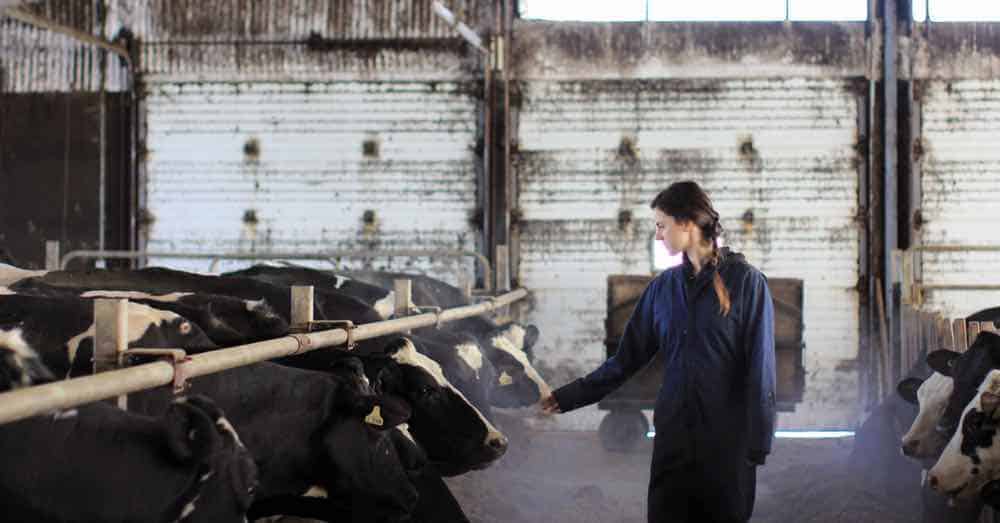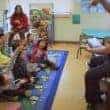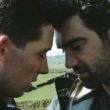Canadian writer-director-editor Heather Young discusses her short, Milk. Watch the film for free here. Young has since made a great feature debut, Murmur, which we interviewed her about here.

Several cows give birth in Canadian filmmaker Heather Young’s short, Milk. It’s a regular enough occurrence that no humans are present, and only a few of the other cows take notice. But the two or three cows nearby monitor the birthing one, checking on the calf, as it’s pushed out, and the mother, as she labours — even if it requires squeezing their head between the bars in the fence separating them. Giving birth is a group effort, a community event, and there are always multiple cows in the frame. It’s also part of the routine of the dairy farm, alongside mechanized milking with its rhythmic pulsing, laying out hay by machine, and disposing of feces via assembly line ribbon.
But for Beatrice, the woman who cares for these cows, pregnancy is a complicated and lonely business. It’s also one that isn’t necessarily expected to happen: she wasn’t using birth control, but the mere existence of such measures shows the difference between human and bovine reproduction norms. Whether it’s visiting the doctor for a checkup, processing what’s happened, or calling her on-again-off-again boyfriend to share the news, Beatrice is alone, and Young isolates her in the frame to show this.
Part observational animal documentary and part low key drama, Milk is a compelling look at often overlooked processes: dairy cows are constantly cycling through pregnancies, while anything that interrupts a woman’s menstrual cycle is a cause for concern or care. After its world premiere at TIFF, Milk screened at Montreal’s Festival du Nouveau Cinema, and it’s now available to view in its online sibling on FestivalScope. I talked to writer-director-editor Young via email about the making of this moving and illuminating film.
Seventh Row (7R): What was the genesis of the film? What made you want to tell this story now?
Heather Young (HY): The idea for Milk began to form while visiting my cousin, who had recently moved to Truro, Nova Scotia to live with her boyfriend Alex, a large animal veterinarian. His family owns and operates a dairy farm, and in addition to being a vet, he also helps out there. I have always been fascinated by animals and was eager to visit the farm and meet the cows.
While being shown around, I learned something that I couldn’t believe hadn’t occurred to me before: in order for cows to produce milk, they have to have recently given birth. I felt very foolish for not having thought about this before, somehow assuming that, like chickens produce eggs, cows are just always ready for milking. A dairy cow is in a constant cycle of being pregnant, giving birth, and then being milked. During one visit, I saw a calf a few minutes after it was born. Even though it was her first time, the mother cow knew exactly what to do and immediately began licking her calf. It was after seeing this I began to think about maternal instincts in animals vs. humans, and the doubts and anxieties that can exist for people surrounding reproduction.
7R: How did you work with your DP to develop the aesthetic for the film?
HY: I was immediately inspired visually by the environment of the dairy farm and knew that I wanted to shoot there. I decided that I wanted to challenge myself more than I had in my previous work to create images that represented the theme. For this film, that meant images that I felt conveyed anxiety and apprehension surrounding the process of reproduction. An example of one of these would be the close-up of the milking machine mechanically extracting milk from the cow’s swollen udder.
I visited the farm several times in advance of the shoot and did some test shooting, which was very helpful in the planning process. Each time I was there, I discovered something new that I was excited to film. The farm is rich with fascinating and unusual sights. My director of photography, Daniel Boos, was a huge resource to me and my strongest creative partner on this project. He challenged me to push myself further with the aesthetic of the film, both with the visuals and the edit.
[clickToTweet tweet=” ‘The farm is rich with fascinating and unusual sights.’ – Heather Young” quote=” ‘The farm is rich with fascinating and unusual sights.’ – Heather Young”]
7R: The machinery surrounding female reproduction takes centre stage in the film. How did you think about filming the machinery for milking vs the medical machinery being used for your protagonist?
HY: I’m fascinated by the confluence of machinery and the living animal and the industrialization of the birthing process. There’s something compelling and subtly threatening to me about taking something that occurs naturally and mechanizing it. I definitely wanted to draw a parallel between the cow’s experience and the experience of my protagonist Beatrice.
The inclusion of this mechanical repetition, in what is supposed to be a natural and even magical occurrence, creates a certain level of dread and anxiety that is conveyed to Beatrice. As she takes part in the mechanized process of the cow’s reproductive cycle, she is able to imagine herself in similar situations with her own pregnancy — for example, when she observes the ultrasound being performed on a cow. Also, by utilizing the milking machine on the cows, she is able to imagine what it will mean for her to be a milk producer, and further, what the consequences of having a baby will have on her future life.
[clickToTweet tweet=”‘I’m fascinated by the confluence of machinery, the living animal, and the industrialization of birthing.'” quote=”‘I’m fascinated by the confluence of machinery, the living animal, and the industrialization of birthing.'”]
7R: How did you approach the sound design for the film? The mechanized sound is really quite rhythmic and often seems like a score unto itself.
HY: The dairy farm is an environment that is not only rich in visuals but also in sounds. I decided during the editing process that I didn’t want to use any music in the film, and instead, create a complex, immersive, and sometimes rhythmic sound design, using and inspired by the natural sounds that we recorded in the barn.
During the milking of the cows, the sound of the machine is very loud and creates a distinctive beat that corresponds with the suction from the device and is visualized in the pulsating of the milkers and the rhythmic squirts of the cow’s milk into the collection containers. This beat created a kind of throbbing score to those scenes and really highlighted the sense of dread, uneasiness, and apprehension I was trying to create. I had a wonderful sound designer, Graham Colwell, who added textures and layers that I would never have thought of on my own.
[clickToTweet tweet=”‘This beat created a kind of throbbing score to those scenes and really highlighted the sense of dread.'” quote=”‘This beat created a kind of throbbing score to those scenes and really highlighted the sense of dread.'”]
7R: How did you think about the parallels that you wanted to show between the protagonist and the cows?
HY: I wanted to draw a parallel between their experiences without being too heavy-handed. The experience of the cows serves to constantly remind Beatrice of her own situation and causes her to reflect on the experience of giving birth and being a mother. I wanted to show a cow giving birth and for the audience to imagine Beatrice observing this lengthy and trying event. How would you feel watching this if you knew you were to be soon going through something similar? Through observing the animal world, she begins to doubt her own maternal instincts, her desire and capacity to be a single parent, and her place in the natural cycle of the world.
[clickToTweet tweet=”‘Through observing the animal world, she begins to doubt her own maternal instincts.’ – Heather Young” quote=”‘Through observing the animal world, she begins to doubt her own maternal instincts.’ – Heather Young”]
7R: What are you working on next?
HY: I am in the early stages of writing and coming up with ideas for a new project. I have done several short films now and would like to take on the challenge of a longer feature project, although I do plan on continuing to make shorts as well. I will likely continue to work with some themes I have started exploring in my shorts, including the experience of the single mother and the relationships formed between lonely people and animals.
Stream the film now for free
Milk from Heather Young on Vimeo.

